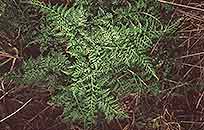Asplenium adiantum-nigrum L. var. solidum (Kunze) J.P. Roux
Synonyms |
Asplenium solidum Kunze |
|---|---|
Common name |
|
Description |
Rhizome shortly creeping, ± 4 mm diameter; rhizome scales dark brown, lanceolate in outline, with a latticed apearance, up to 2mm long. Fronds closely spaced, thinly coraceous, not proliferous. Stipe 5–20 cm long, black, shiny, hairless, the subterranean stipe bases are prominently swollen, succulent and pale green. Lamina narrowly ovate to lanceolate in outline, 12–32 x 5-12.5 cm, 3 to 4-pinnatifid. Pinnae triangular to broadly ovate in outline, angled forward at 45°, pinna lobes progressively more dissected towards the base, upper surface hairless, lower surface subglabrous, margin unevenly dentate with 3-6 large teeth on the ultimate lobes. Rhachis black near the base, changing to pale straw coloured towards the apex, hairless. Sori set along the costae and costules, oval in outline, up to 3 mm long; indusium entire. |
Notes | |
Derivation | adiantum-nigrum: black adiantum, vaguely resembling some taxa of the genus Adiantum; solidum: solid, might be a reference to the stipe base that is swollen but without cavities. |
Habitat | Coastal, under scrub on well-established sand-dunes or in rock crevices on stony outcrops or cliffs. |
Distribution worldwide | Endemic to South Africa, where it occurs from the Western to the Eastern Cape. |
Distribution in Africa |
|
Growth form |
Lithophytic, terrestrial. |
Literature |
|
